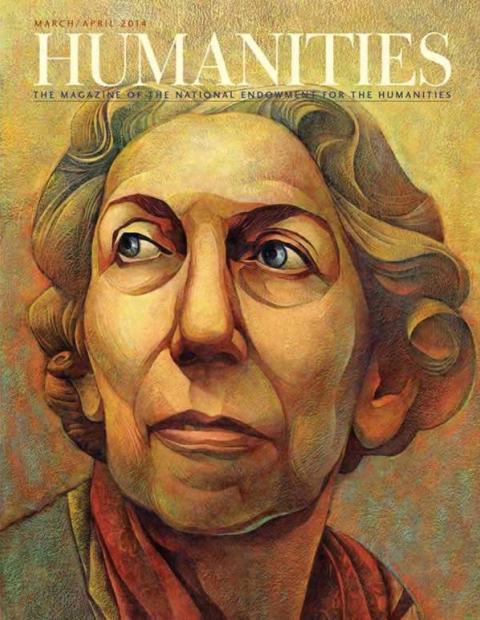A gorgeous 1931 post office-turned-library-turned-art gallery sits in the middle of the main thoroughfare of Monroe (pop. 13,000), just between the city park and the Wells Fargo branch on Broad Street.
This fortuitous location came about because of a tornado, a pressurized cell, or a downburst—depending on the person you hear the story from—that occurred about twenty years ago. The then-abandoned building sustained a lot of water damage, and the Monroe Art Guild, with the blessings of the city, rescued and restored it.
On a frigid January night, a warm glow emanates from the historic building. Inside is the current exhibition, in which there is a painting of a town very much like Monroe, captured in the evening, just as people are getting home and shadows are lengthening.
This piece is Monroe Art Guild director Bryan Hardman’s favorite in the “Inspired Georgia” exhibition, which showcases twenty-eight works from the 1970s to 1990s from Georgia’s State Art Collection and has been hanging at the guild’s gallery since Christmas Eve. “It’s a bird’s-eye view of a neighborhood, people in driveways, lights on in houses, very crisp—the roof lines are so straight it looks like he used a ruler. It reminds me of an architectural drawing,” says Hardman, whose field is architectural and historic preservation, and who lives three blocks from here.
The exhibition is a partnership of the Georgia Humanities Council, the Georgia Council for the Arts—which owns and manages the state’s 600-plus-piece art collection, from which the works were selected—the Georgia Museum of Art, and Explore Georgia.
“We’re a strange state in that we have so much geographic diversity—from the coastal communities to the mountain towns to one of the largest American cities, but when we vacation, we tend to go someplace else,” says Jamil Zainaldin, president of the Georgia Humanities Council. “This is an attempt to reflect that diversity, but ask, Who are we as Georgians? What ties us together?”
Ultimately, nine communities were selected to host the exhibition, which was two years in the making and runs through December. “We required partnerships between an arts entity and a downtown development authority to showcase the role and value of the arts in community and economic revitalization,” says Karen Paty, director of the Georgia Council for the Arts. “We wanted to start a conversation.”
Venues range from small cities like Monroe to the Georgia Museum of Agriculture in Tifton to the historic Train Depot in Kingsland.
The works, including abstracts, black-and-white photography, landscapes, folk art, mixed media, prints, and portraiture, were selected largely by consultant Anne Lambert Tracht, who curated the exhibition. They aren’t just from the “best known” artists in the collection, nor is the entire collection represented—three-dimensional pieces, for instance, were not included for logistical reasons. “The driving factor in our selection process was the quality and power of expression within each work of art, rather than the resumé of its creator,” says Tracht. “We wanted to capture the myriad ways in which art has been created throughout the state that reflects our history as Georgians. It comes from us, it is about us, and it tells our constantly evolving story.”
In some cases, the artists are well known; in others, it was difficult to gather enough information for a bio. There is painter and printmaker Benny Andrews, who received an NEA fellowship in 1974 and has works in the Metropolitan Museum of Art, the Museum of Modern Art, and the Studio Museum in Harlem. Another is Nellie Mae Rowe, the daughter of a slave whose colorful folk art is included in collections at Atlanta’s High Museum, the Smithsonian American Art Museum, and the Library of Congress American Folklife Center. Self-taught folk artist Howard Finster, who completed more than 40,000 pieces during his career, including album covers for REM and the Talking Heads, combined art and preaching at his home in Summerville, dubbed “Paradise Garden,” which will host the exhibit from March 4 through April 17.
The exhibition, like Georgians themselves, exudes a certain steadfast resolve, a sense of old-time religion, a schizophrenic identity, a reverence for nature, music, and home, and a self-deprecating sense of humor. There are children singing with their elders and playing in the spray of a fire hydrant with equal joy, penitents kneeling and angels flying over alien worlds, odes to cityscapes and sunbeams breaking through a forest canopy, reflections on race relations and folks watching TV.
“I’m captivated by the state because you can’t really describe it,” says Zainaldin. “It’s an amazing spectacle to come from a single source, a single place, this large swath of the South we call home.”


